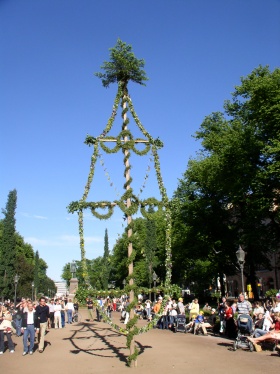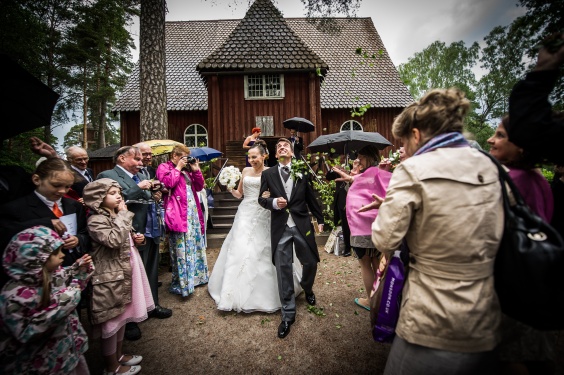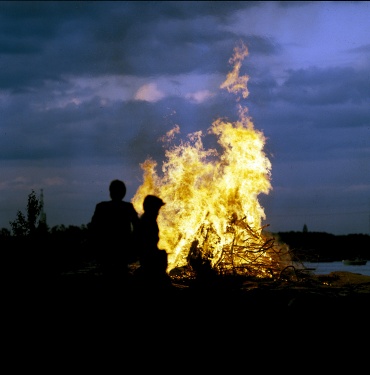Celebrating Midsummer
| Celebrating Midsummer | ||||
|---|---|---|---|---|
|
Practitioners and people who know the tradition well
The traditions and customary ways of celebrating Midsummer are well-known in Finland. Bonfires and Midsummer pole celebrations are arranged by associations and organisations, and open air dance pavilions hold Midsummer dances. Families and other groups celebrate at cottages or in nature. There are also a few large-scale Midsummer celebrations held in Finland. These celebrations are intended for the whole family and they can last for one day or several; they attract both Finns and tourists alike in droves. At the events, age-old traditions grow stronger and new customs are created alongside them. For example, the JuhannusVirrat event has been held in the traditional village of Virrat since 2004, when the town of Virrat appointed itself as the official Midsummer Town. In addition, the Lentäjien Juhannus Midsummer Air Show is held in Kauhava on the grounds of the old air force school, and a traditional Midsummer celebration is arranged in Seurasaari in Helsinki. In the Åland Islands and the Swedish-speaking coastal areas, the events are centred around Midsummer poles.
Practising of the tradition
The bright Midsummer Eve and night are usually celebrated in nature. Cities empty of their inhabitants and there are long queues of cars on the motorways, with people travelling to their family’s summer homes or summer cottages, or a music festival. Shops and most restaurants close at noon on Midsummer Eve, and public transport offers fewer departures. Midsummer Eve is an official holiday in Finland, which means that you can enjoy a long weekend at Midsummer.
Elements of folk traditions that still live on in the Midsummer celebrations include raising the Midsummer pole, lighting a bonfire, and the different forms of dancing, singing and playing. Most events and ceremonies focus on Midsummer Eve, when people gather together to go to sauna and swim, socialise, eat, and drink. They place birch branches next to door jambs and around gates, and they put wildflowers in vases. Playful magic and telling fortunes are also practised according to the ancient customs. At Midsummer, people often go dancing at open air dance pavilions, visit the village festival, or go to a Midsummer church service. Young people gather at rock festivals or campsites. At Midsummer Eve, people hoist the Finnish flag up on the flagpole, where it can stay until the next evening, because Midsummer is an official flag day. Midsummer is celebrated in Finland between 19 and 26 June, and Midsummer Eve always falls on a Friday.
The background and history of the tradition
The celebration of Midsummer was originally dedicated to Ukko, the god of weather. The purpose of the celebration was to ensure good crops and fertility for the next year for people whose livelihood depended on agriculture. The Roman Catholic Church fixed the date on the Nativity of St John the Baptist, ‘Nativitas Johannis Baptiste’, in 1316. In time, the name Johannes, or John, gave the Midsummer celebration its current Finnish name ‘Juhannus’. Even today, folk and church traditions live on side-by-side in the Midsummer celebrations. In the folk calendar, Midsummer was the most important annual holiday in the summer. The bright Midsummer night was spent as close to nature as possible, since it was believed that nature contained a special magic. During the brief moment of midnight, it was customary to read omens in nature and practise magic. The magic was particularly practised to ensure luck in finding a spouse, but people also wanted to ensure their luck with cattle, butter, milk and crops. Unmarried maidens cast love spells in the Midsummer sauna, by jumping over the bonfire or by rolling in rye fields.
The Finnish Midsummer bonfire tradition is a part of a common custom in European agricultural cultures, where bonfires are lit during celebrations. In addition to Midsummer, bonfires and other fires have also been lit on other holidays, such as Easter, Pentecost, May Day, or the kekri harvest festival. Out of these, the Midsummer bonfire is the most vital and widespread in Finland. Fire was seen as a powerful and purifying element. People predicted luck in finding a spouse based on the way the bonfire burnt, and lighting the bonfire was considered to promote fertility and ward off evil. Bonfires were usually built near bodies of water and in high places. Originally, bonfires were an eastern Finnish tradition, but today they are lit in all parts of the country. The oldest written description of lighting Midsummer bonfires is from Turku in 1645.
In Northern Finland, the sun does not set at all in the summer, and therefore people have been able to admire the midnight sun during Midsummer. The most well-known place to see the sun was Aavasaksa Hill, which became famous as early as in the 1700s thanks to visits by international explorers and statesmen.
The transmission of the tradition
Midsummer traditions are passed on naturally within families, among kin and at events. The press, radio and TV as well as the internet also pass information on to future generations. The public is especially interested in the magical traditions linked to Midsummer.
The future of the tradition
The summer cottage culture and the close connection Finns have with nature make sure that the ways of celebrating Midsummer are preserved and passed on in their different forms. The Midsummer customs and traditions are strong and established. In fact, the Midsummer celebration is not at risk as long as Midsummer Eve remains a statutory holiday.
The community/communities behind this submission
Seurasaarisäätiö (Seurasaari Foundation)
Bibliography and links to external sources of information
Yle Elävä Arkisto 2006. Juhannusyö Aavasaksalla 1946.
Nieminen, Aila & Olsson, Pia 2016: Festivalisoitu juhannus ja elävä perinne. Teoksessa Festivaalien Suomi. Toim. Satu Silvanto. Cuporen julkaisuja 29. Kulttuuripoliittisen tutkimuksen edistämissäätiö. Helsinki.
Moilanen, Raija 2007. [1]. Kotus.
Seurasaarisäätiö 2003. Suomalaisen juhannusperinteen bibliografia.
Seurasaarisäätiö 2016. Seurasaaren juhannusvalkeat.
Virrat. [2].
Visit Finland. Midsummer – Go Peaceful or Go Party.



